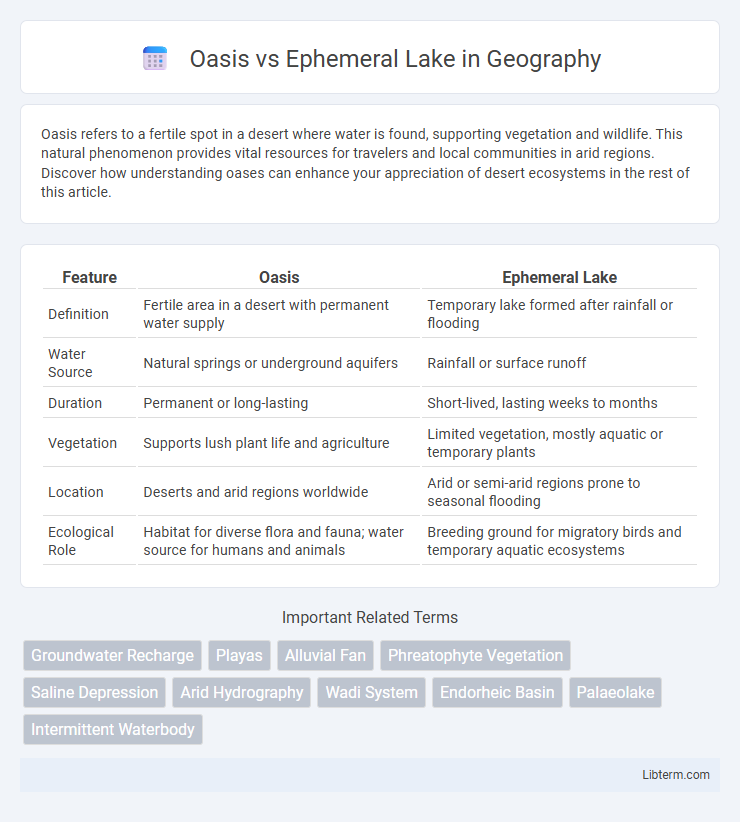Oasis refers to a fertile spot in a desert where water is found, supporting vegetation and wildlife. This natural phenomenon provides vital resources for travelers and local communities in arid regions. Discover how understanding oases can enhance your appreciation of desert ecosystems in the rest of this article.
Table of Comparison
| Feature | Oasis | Ephemeral Lake |
|---|---|---|
| Definition | Fertile area in a desert with permanent water supply | Temporary lake formed after rainfall or flooding |
| Water Source | Natural springs or underground aquifers | Rainfall or surface runoff |
| Duration | Permanent or long-lasting | Short-lived, lasting weeks to months |
| Vegetation | Supports lush plant life and agriculture | Limited vegetation, mostly aquatic or temporary plants |
| Location | Deserts and arid regions worldwide | Arid or semi-arid regions prone to seasonal flooding |
| Ecological Role | Habitat for diverse flora and fauna; water source for humans and animals | Breeding ground for migratory birds and temporary aquatic ecosystems |
Introduction to Oases and Ephemeral Lakes
Oases are fertile areas in deserts where groundwater reaches the surface, supporting vegetation and human settlement, often serving as crucial hubs in arid regions. Ephemeral lakes, also known as temporary or seasonal lakes, form intermittently after rainfall or flooding, disappearing as water evaporates or drains away. Both features play significant ecological roles by providing habitats and resources in otherwise dry landscapes.
Defining Oases: Characteristics and Formation
Oases are fertile areas in deserts where groundwater reaches the surface, supporting vegetation and human habitation. They form through natural springs, underground rivers, or aquifers that provide a stable water supply, enabling agriculture and settlement in otherwise arid regions. The constant availability of water differentiates oases from ephemeral lakes, which are temporary and reliant on seasonal rainfall.
Understanding Ephemeral Lakes: Features and Occurrence
Ephemeral lakes are temporary water bodies that form in low-lying areas after precipitation or flooding, typically drying up during dry seasons. These lakes exhibit high salinity and variable water chemistry due to rapid evaporation and mineral concentration. Commonly found in arid and semi-arid regions, ephemeral lakes contribute to unique ecological habitats and influence groundwater recharge patterns.
Geographic Distribution: Where Are Oases and Ephemeral Lakes Found?
Oases are primarily found in arid and desert regions such as the Sahara Desert in Africa, the Arabian Peninsula, and parts of Central Asia where underground water sources reach the surface, supporting vegetation and human settlement. Ephemeral lakes occur in dry climates worldwide, including Australia's interior deserts, the southwestern United States, and parts of Africa, filling temporarily after seasonal rains or floods and then rapidly evaporating. The geographic distribution of oases is linked to stable groundwater availability, while ephemeral lakes are more widespread and dependent on intermittent surface water accumulation.
Water Sources: Sustaining Oases vs. Ephemeral Lakes
Oases rely on consistent underground aquifers or natural springs to provide a steady water source that sustains vegetation and human settlements over long periods. In contrast, ephemeral lakes depend on temporary water inputs from rainfall, surface runoff, or seasonal flooding, leading to water presence only for short durations. The permanence of water in oases supports more stable ecosystems, while ephemeral lakes create transient habitats adapted to fluctuating water availability.
Ecological Significance and Biodiversity
Oases serve as permanent water sources in arid regions, supporting stable ecosystems with diverse plant and animal species adapted to continuous hydration. Ephemeral lakes, characterized by temporary water presence following rain events, create dynamic habitats that foster seasonal biodiversity, including migratory birds and specialized aquatic organisms. The contrasting water availability patterns between oases and ephemeral lakes drive unique ecological functions critical for maintaining regional biodiversity and resilience in desert ecosystems.
Human Interaction and Cultural Importance
Oases have historically served as vital hubs for human settlement, agriculture, and trade, fostering the development of rich cultural traditions and social networks in arid regions. Ephemeral lakes, while less stable, play a crucial role in temporary resource availability, influencing nomadic patterns and seasonal rituals among indigenous communities. The contrasting permanence of oases versus the transient nature of ephemeral lakes shapes distinct forms of human interaction and cultural significance in desert environments.
Adaptations of Flora and Fauna
Oasis ecosystems support diverse flora and fauna adapted to stable water availability, including date palms with deep root systems and resident animals such as migratory birds and camels that thrive on consistent resources. In contrast, ephemeral lakes host flora and fauna uniquely adapted to extreme fluctuations in water presence, with plants like salt-tolerant halophytes and animals such as brine shrimp and seasonal amphibians capable of rapid life cycles during brief wet periods. These adaptations illustrate the contrasting survival strategies in oasis environments characterized by permanent water sources versus ephemeral lakes defined by transient aquatic conditions.
Challenges and Threats: Environmental Changes
Oasis environments face severe challenges from rising temperatures and prolonged droughts, leading to water scarcity and reduced vegetation cover. Ephemeral lakes are threatened by unpredictable rainfall patterns and increased evaporation rates, causing shorter water retention periods and habitat loss for aquatic species. Both ecosystems suffer from climate change-induced stresses that disrupt their delicate hydrological balance and biodiversity.
Conclusion: Key Differences and Takeaways
Oases are permanent water sources in deserts, supporting diverse vegetation and human settlements, while ephemeral lakes are temporary, forming only after rain and drying quickly. The key difference lies in their duration and stability; oases provide reliable resources year-round, whereas ephemeral lakes offer transient habitats and limited ecological impact. Understanding these distinctions is crucial for managing desert ecosystems and planning sustainable water use in arid regions.
Oasis Infographic

 libterm.com
libterm.com